实例介绍
【实例截图】
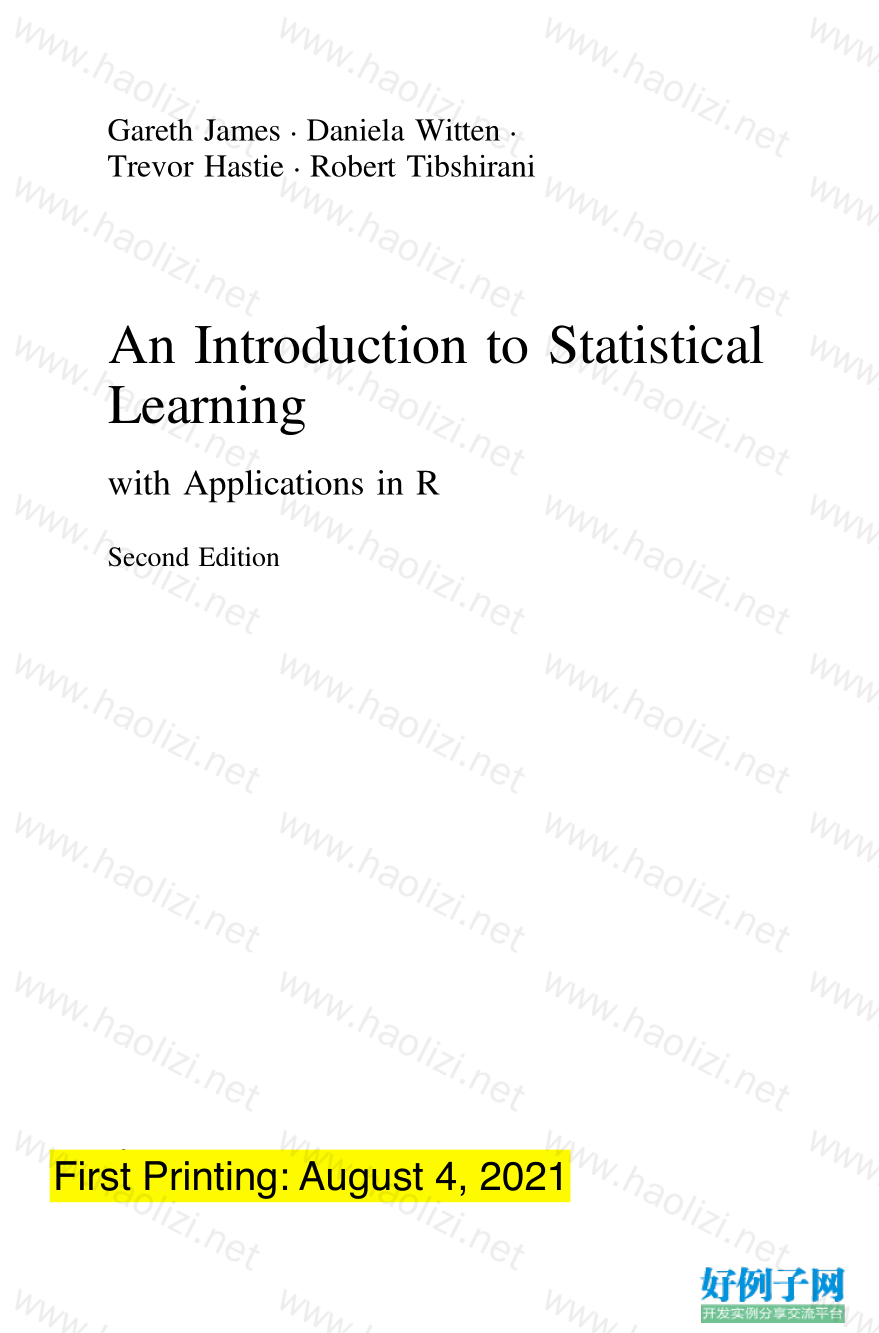



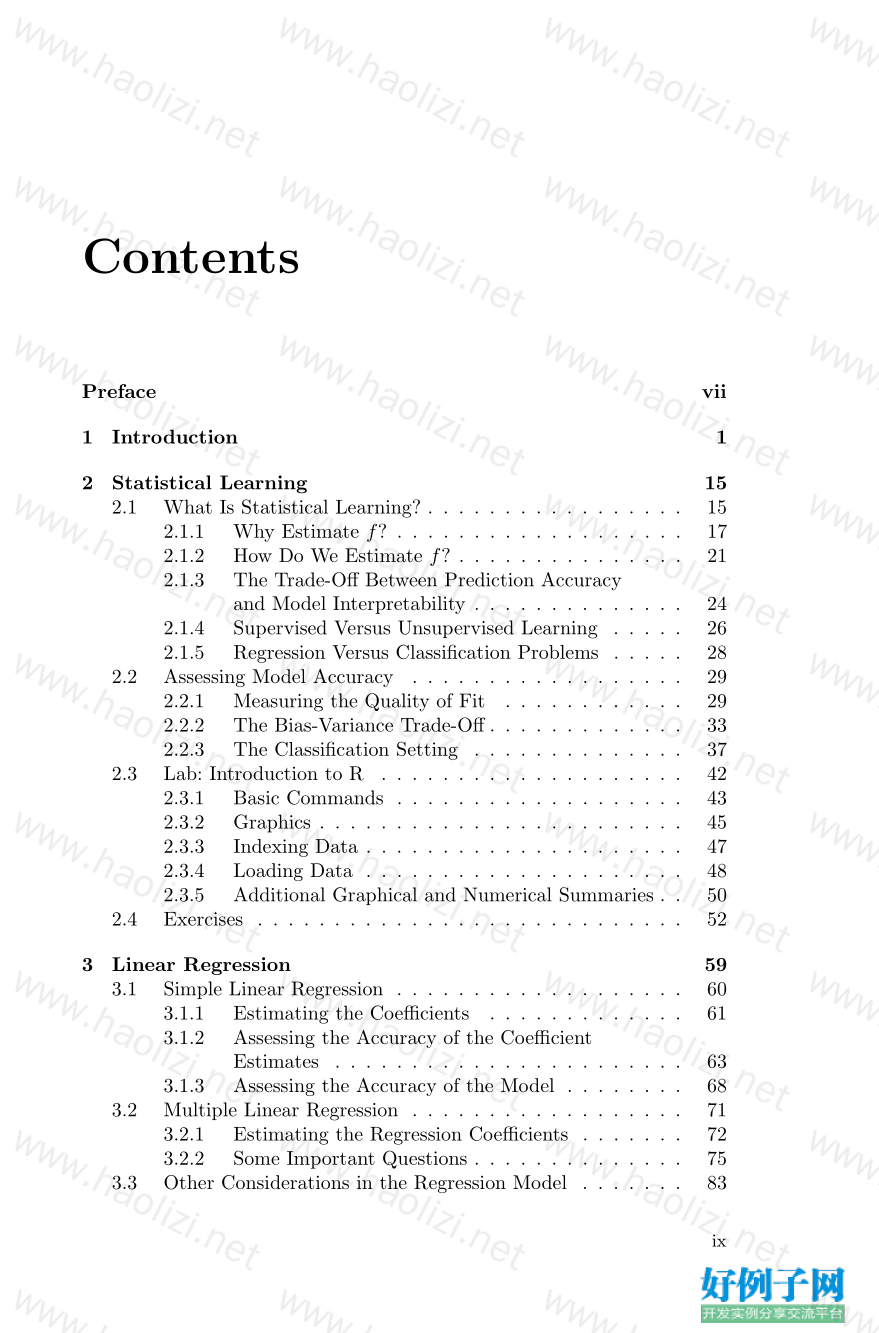

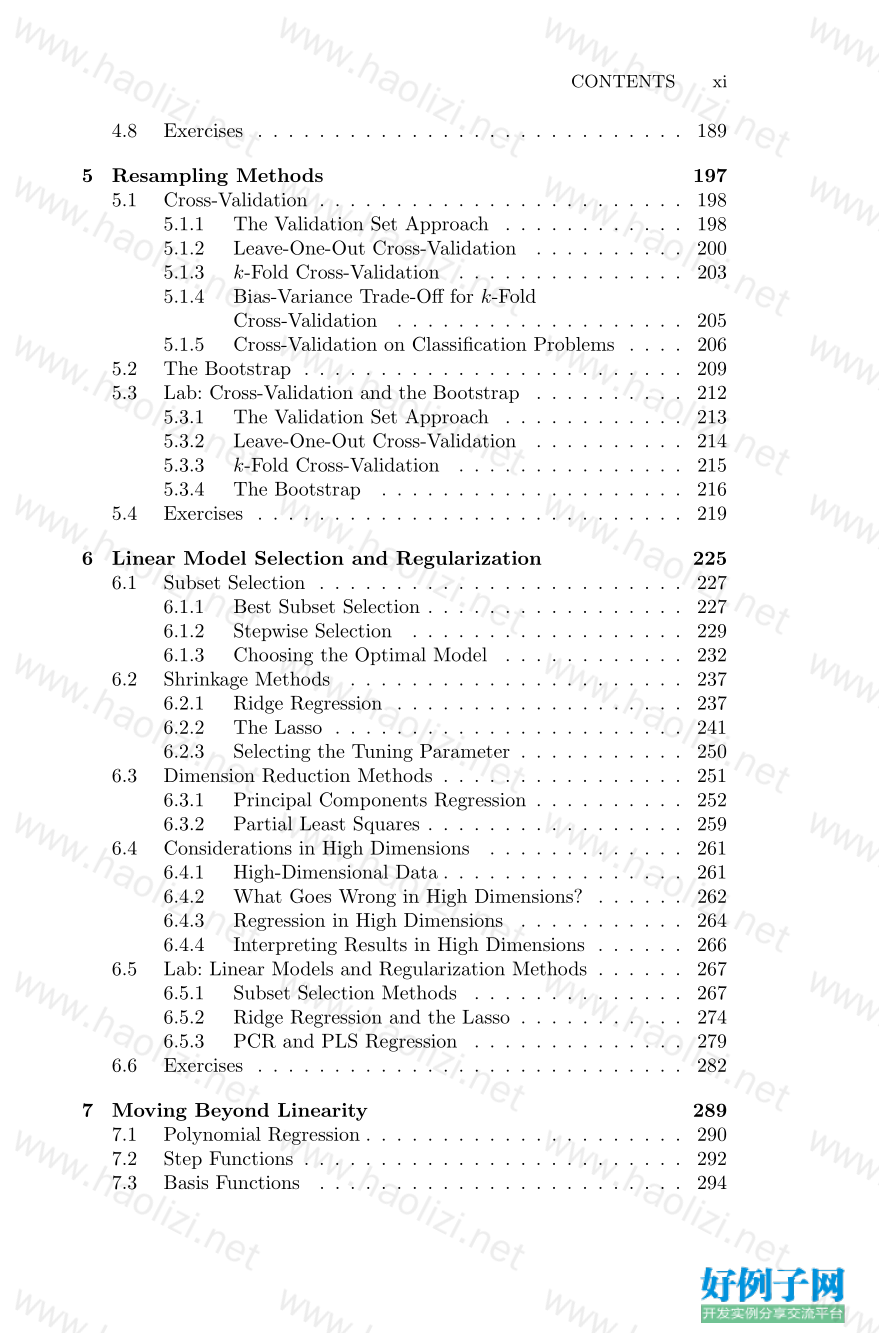
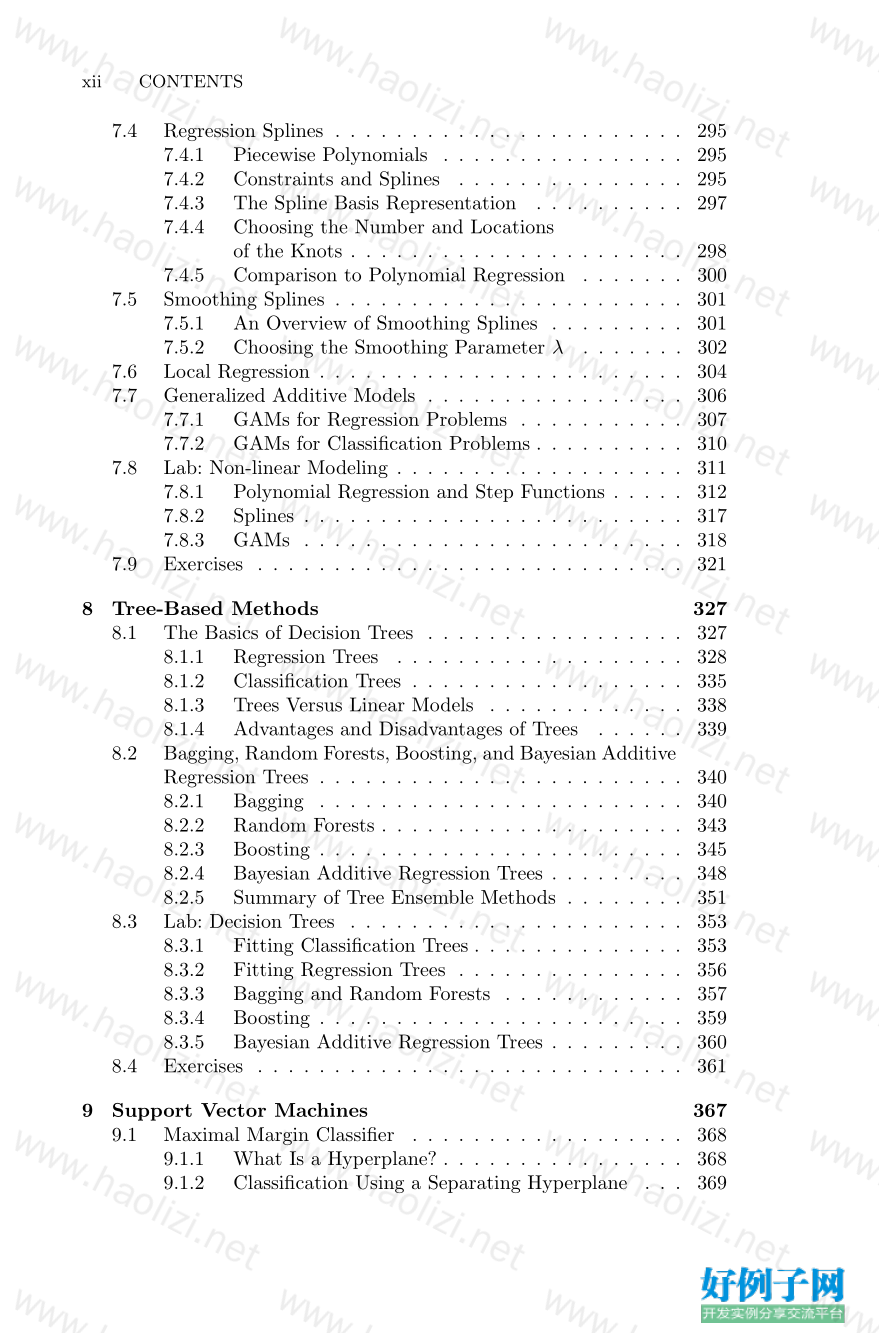
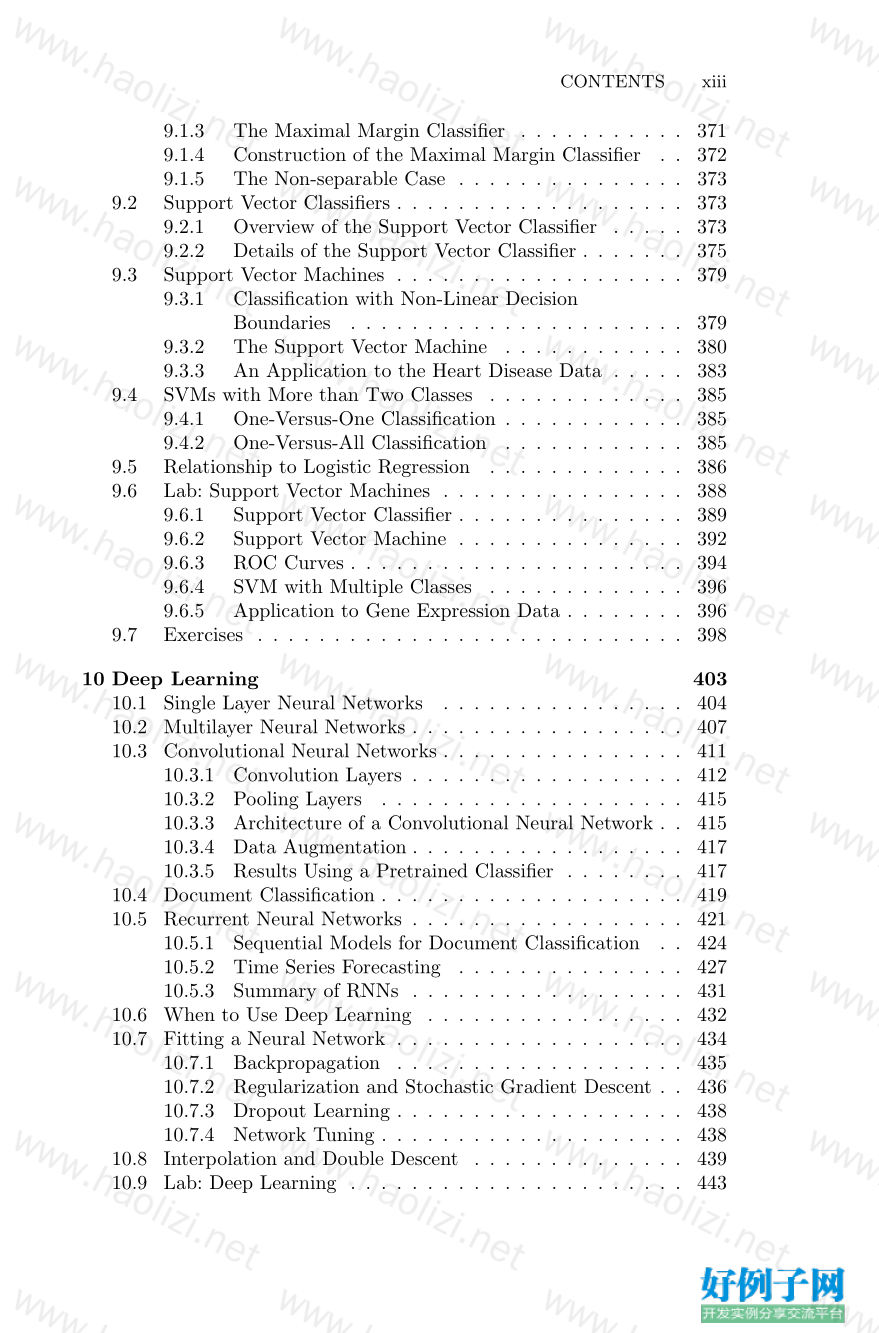
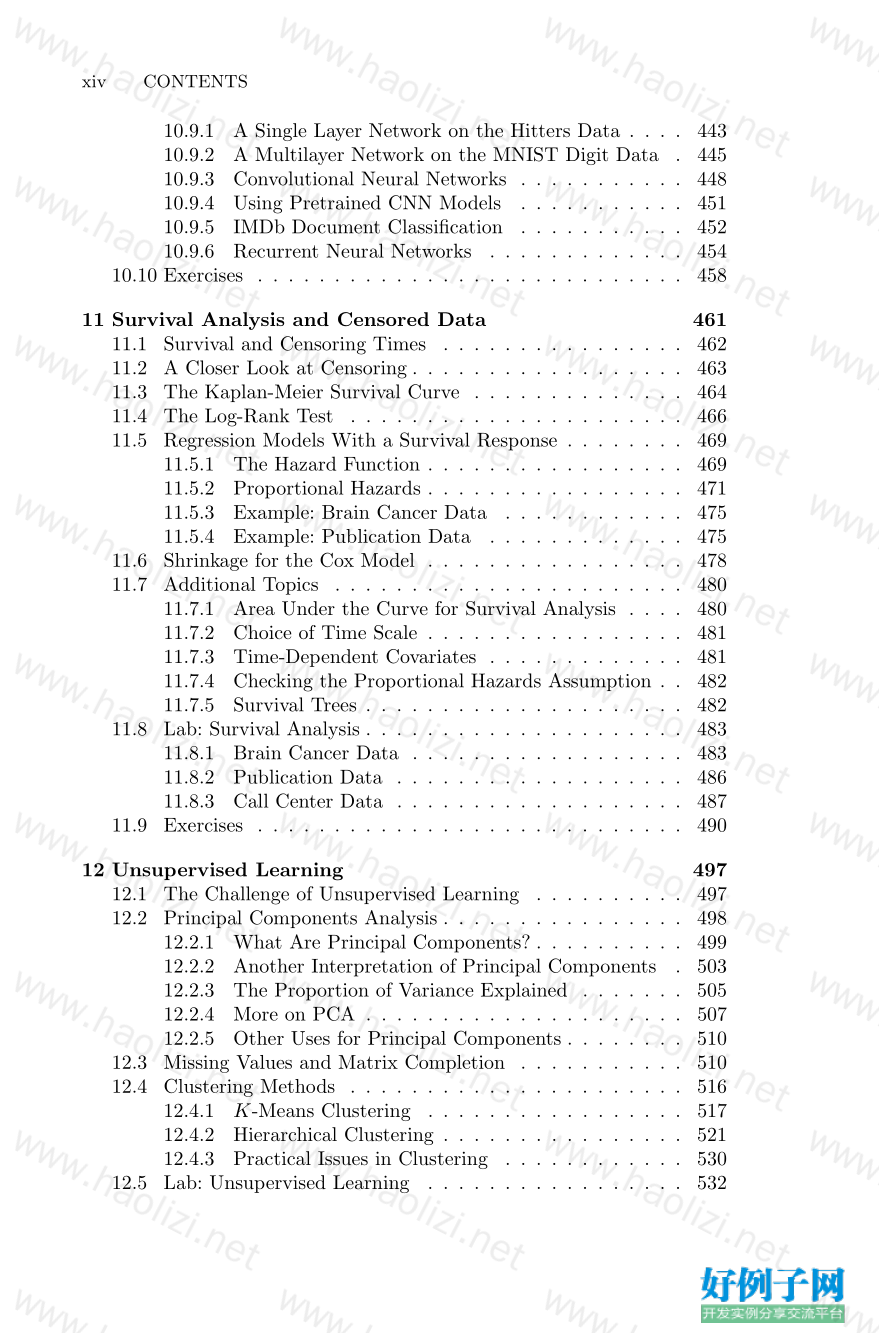

【核心代码】R语言
Contents
Preface vii
1 Introduction 1
2 Statistical Learning 15
2.1 What Is Statistical Learning? . . . . . . . . . . . . . . . . . 15
2.1.1 Why Estimate f? . . . . . . . . . . . . . . . . . . . 17
2.1.2 How Do We Estimate f? . . . . . . . . . . . . . . . 21
2.1.3 The Trade-Off Between Prediction Accuracy
and Model Interpretability . . . . . . . . . . . . . . 24
2.1.4 Supervised Versus Unsupervised Learning . . . . . 26
2.1.5 Regression Versus Classification Problems . . . . . 28
2.2 Assessing Model Accuracy . . . . . . . . . . . . . . . . . . 29
2.2.1 Measuring the Quality of Fit . . . . . . . . . . . . 29
2.2.2 The Bias-Variance Trade-Off . . . . . . . . . . . . . 33
2.2.3 The Classification Setting . . . . . . . . . . . . . . 37
2.3 Lab: Introduction to R . . . . . . . . . . . . . . . . . . . . 42
2.3.1 Basic Commands . . . . . . . . . . . . . . . . . . . 43
2.3.2 Graphics . . . . . . . . . . . . . . . . . . . . . . . . 45
2.3.3 Indexing Data . . . . . . . . . . . . . . . . . . . . . 47
2.3.4 Loading Data . . . . . . . . . . . . . . . . . . . . . 48
2.3.5 Additional Graphical and Numerical Summaries . . 50
2.4 Exercises . . . . . . . . . . . . . . . . . . . . . . . . . . . . 52
3 Linear Regression 59
3.1 Simple Linear Regression . . . . . . . . . . . . . . . . . . . 60
3.1.1 Estimating the Coefficients . . . . . . . . . . . . . 61
3.1.2 Assessing the Accuracy of the Coefficient
Estimates . . . . . . . . . . . . . . . . . . . . . . . 63
3.1.3 Assessing the Accuracy of the Model . . . . . . . . 68
3.2 Multiple Linear Regression . . . . . . . . . . . . . . . . . . 71
3.2.1 Estimating the Regression Coefficients . . . . . . . 72
3.2.2 Some Important Questions . . . . . . . . . . . . . . 75
3.3 Other Considerations in the Regression Model . . . . . . . 83
ix
3.3.1 Qualitative Predictors . . . . . . . . . . . . . . . . 83
3.3.2 Extensions of the Linear Model . . . . . . . . . . . 87
3.3.3 Potential Problems . . . . . . . . . . . . . . . . . . 92
3.4 The Marketing Plan . . . . . . . . . . . . . . . . . . . . . . 103
3.5 Comparison of Linear Regression with K-Nearest
Neighbors . . . . . . . . . . . . . . . . . . . . . . . . . . . . 105
3.6 Lab: Linear Regression . . . . . . . . . . . . . . . . . . . . 110
3.6.1 Libraries . . . . . . . . . . . . . . . . . . . . . . . . 110
3.6.2 Simple Linear Regression . . . . . . . . . . . . . . . 111
3.6.3 Multiple Linear Regression . . . . . . . . . . . . . . 114
3.6.4 Interaction Terms . . . . . . . . . . . . . . . . . . . 116
3.6.5 Non-linear Transformations of the Predictors . . . 116
3.6.6 Qualitative Predictors . . . . . . . . . . . . . . . . 119
3.6.7 Writing Functions . . . . . . . . . . . . . . . . . . . 120
3.7 Exercises . . . . . . . . . . . . . . . . . . . . . . . . . . . . 121
4 Classification 129
4.1 An Overview of Classification . . . . . . . . . . . . . . . . . 130
4.2 Why Not Linear Regression? . . . . . . . . . . . . . . . . . 131
4.3 Logistic Regression . . . . . . . . . . . . . . . . . . . . . . 133
4.3.1 The Logistic Model . . . . . . . . . . . . . . . . . . 133
4.3.2 Estimating the Regression Coefficients . . . . . . . 135
4.3.3 Making Predictions . . . . . . . . . . . . . . . . . . 136
4.3.4 Multiple Logistic Regression . . . . . . . . . . . . . 137
4.3.5 Multinomial Logistic Regression . . . . . . . . . . . 140
4.4 Generative Models for Classification . . . . . . . . . . . . . 141
4.4.1 Linear Discriminant Analysis for p = 1 . . . . . . . 142
4.4.2 Linear Discriminant Analysis for p >1 . . . . . . . 145
4.4.3 Quadratic Discriminant Analysis . . . . . . . . . . 152
4.4.4 Naive Bayes . . . . . . . . . . . . . . . . . . . . . . 153
4.5 A Comparison of Classification Methods . . . . . . . . . . 158
4.5.1 An Analytical Comparison . . . . . . . . . . . . . . 158
4.5.2 An Empirical Comparison . . . . . . . . . . . . . . 161
4.6 Generalized Linear Models . . . . . . . . . . . . . . . . . . 164
4.6.1 Linear Regression on the Bikeshare Data . . . . . . 164
4.6.2 Poisson Regression on the Bikeshare Data . . . . . 167
4.6.3 Generalized Linear Models in Greater Generality . 170
4.7 Lab: Classification Methods . . . . . . . . . . . . . . . . . . 171
4.7.1 The Stock Market Data . . . . . . . . . . . . . . . 171
4.7.2 Logistic Regression . . . . . . . . . . . . . . . . . . 172
4.7.3 Linear Discriminant Analysis . . . . . . . . . . . . 177
4.7.4 Quadratic Discriminant Analysis . . . . . . . . . . 179
4.7.5 Naive Bayes . . . . . . . . . . . . . . . . . . . . . . 180
4.7.6 K-Nearest Neighbors . . . . . . . . . . . . . . . . . 181
4.7.7 Poisson Regression . . . . . . . . . . . . . . . . . . 185
x CONTENTS
CONTENTS xi
4.8 Exercises . . . . . . . . . . . . . . . . . . . . . . . . . . . . 189
5 Resampling Methods 197
5.1 Cross-Validation . . . . . . . . . . . . . . . . . . . . . . . . 198
5.1.1 The Validation Set Approach . . . . . . . . . . . . 198
5.1.2 Leave-One-Out Cross-Validation . . . . . . . . . . 200
5.1.3 k-Fold Cross-Validation . . . . . . . . . . . . . . . 203
5.1.4 Bias-Variance Trade-Off for k-Fold
Cross-Validation . . . . . . . . . . . . . . . . . . . 205
5.1.5 Cross-Validation on Classification Problems . . . . 206
5.2 The Bootstrap . . . . . . . . . . . . . . . . . . . . . . . . . 209
5.3 Lab: Cross-Validation and the Bootstrap . . . . . . . . . . 212
5.3.1 The Validation Set Approach . . . . . . . . . . . . 213
5.3.2 Leave-One-Out Cross-Validation . . . . . . . . . . 214
5.3.3 k-Fold Cross-Validation . . . . . . . . . . . . . . . 215
5.3.4 The Bootstrap . . . . . . . . . . . . . . . . . . . . 216
5.4 Exercises . . . . . . . . . . . . . . . . . . . . . . . . . . . . 219
6 Linear Model Selection and Regularization 225
6.1 Subset Selection . . . . . . . . . . . . . . . . . . . . . . . . 227
6.1.1 Best Subset Selection . . . . . . . . . . . . . . . . . 227
6.1.2 Stepwise Selection . . . . . . . . . . . . . . . . . . 229
6.1.3 Choosing the Optimal Model . . . . . . . . . . . . 232
6.2 Shrinkage Methods . . . . . . . . . . . . . . . . . . . . . . 237
6.2.1 Ridge Regression . . . . . . . . . . . . . . . . . . . 237
6.2.2 The Lasso . . . . . . . . . . . . . . . . . . . . . . . 241
6.2.3 Selecting the Tuning Parameter . . . . . . . . . . . 250
6.3 Dimension Reduction Methods . . . . . . . . . . . . . . . . 251
6.3.1 Principal Components Regression . . . . . . . . . . 252
6.3.2 Partial Least Squares . . . . . . . . . . . . . . . . . 259
6.4 Considerations in High Dimensions . . . . . . . . . . . . . 261
6.4.1 High-Dimensional Data . . . . . . . . . . . . . . . . 261
6.4.2 What Goes Wrong in High Dimensions? . . . . . . 262
6.4.3 Regression in High Dimensions . . . . . . . . . . . 264
6.4.4 Interpreting Results in High Dimensions . . . . . . 266
6.5 Lab: Linear Models and Regularization Methods . . . . . . 267
6.5.1 Subset Selection Methods . . . . . . . . . . . . . . 267
6.5.2 Ridge Regression and the Lasso . . . . . . . . . . . 274
6.5.3 PCR and PLS Regression . . . . . . . . . . . . . . 279
6.6 Exercises . . . . . . . . . . . . . . . . . . . . . . . . . . . . 282
7 Moving Beyond Linearity 289
7.1 Polynomial Regression . . . . . . . . . . . . . . . . . . . . . 290
7.2 Step Functions . . . . . . . . . . . . . . . . . . . . . . . . . 292
7.3 Basis Functions . . . . . . . . . . . . . . . . . . . . . . . . 294
7.4 Regression Splines . . . . . . . . . . . . . . . . . . . . . . . 295
7.4.1 Piecewise Polynomials . . . . . . . . . . . . . . . . 295
7.4.2 Constraints and Splines . . . . . . . . . . . . . . . 295
7.4.3 The Spline Basis Representation . . . . . . . . . . 297
7.4.4 Choosing the Number and Locations
of the Knots . . . . . . . . . . . . . . . . . . . . . . 298
7.4.5 Comparison to Polynomial Regression . . . . . . . 300
7.5 Smoothing Splines . . . . . . . . . . . . . . . . . . . . . . . 301
7.5.1 An Overview of Smoothing Splines . . . . . . . . . 301
7.5.2 Choosing the Smoothing Parameter λ . . . . . . . 302
7.6 Local Regression . . . . . . . . . . . . . . . . . . . . . . . . 304
7.7 Generalized Additive Models . . . . . . . . . . . . . . . . . 306
7.7.1 GAMs for Regression Problems . . . . . . . . . . . 307
7.7.2 GAMs for Classification Problems . . . . . . . . . . 310
7.8 Lab: Non-linear Modeling . . . . . . . . . . . . . . . . . . . 311
7.8.1 Polynomial Regression and Step Functions . . . . . 312
7.8.2 Splines . . . . . . . . . . . . . . . . . . . . . . . . . 317
7.8.3 GAMs . . . . . . . . . . . . . . . . . . . . . . . . . 318
7.9 Exercises . . . . . . . . . . . . . . . . . . . . . . . . . . . . 321
8 Tree-Based Methods 327
8.1 The Basics of Decision Trees . . . . . . . . . . . . . . . . . 327
8.1.1 Regression Trees . . . . . . . . . . . . . . . . . . . 328
8.1.2 Classification Trees . . . . . . . . . . . . . . . . . . 335
8.1.3 Trees Versus Linear Models . . . . . . . . . . . . . 338
8.1.4 Advantages and Disadvantages of Trees . . . . . . 339
8.2 Bagging, Random Forests, Boosting, and Bayesian Additive
Regression Trees . . . . . . . . . . . . . . . . . . . . . . . . 340
8.2.1 Bagging . . . . . . . . . . . . . . . . . . . . . . . . 340
8.2.2 Random Forests . . . . . . . . . . . . . . . . . . . . 343
8.2.3 Boosting . . . . . . . . . . . . . . . . . . . . . . . . 345
8.2.4 Bayesian Additive Regression Trees . . . . . . . . . 348
8.2.5 Summary of Tree Ensemble Methods . . . . . . . . 351
8.3 Lab: Decision Trees . . . . . . . . . . . . . . . . . . . . . . 353
8.3.1 Fitting Classification Trees . . . . . . . . . . . . . . 353
8.3.2 Fitting Regression Trees . . . . . . . . . . . . . . . 356
8.3.3 Bagging and Random Forests . . . . . . . . . . . . 357
8.3.4 Boosting . . . . . . . . . . . . . . . . . . . . . . . . 359
8.3.5 Bayesian Additive Regression Trees . . . . . . . . . 360
8.4 Exercises . . . . . . . . . . . . . . . . . . . . . . . . . . . . 361
9 Support Vector Machines 367
9.1 Maximal Margin Classifier . . . . . . . . . . . . . . . . . . 368
9.1.1 What Is a Hyperplane? . . . . . . . . . . . . . . . . 368
9.1.2 Classification Using a Separating Hyperplane . . . 369
xii CONTENTS
CONTENTS xiii
9.1.3 The Maximal Margin Classifier . . . . . . . . . . . 371
9.1.4 Construction of the Maximal Margin Classifier . . 372
9.1.5 The Non-separable Case . . . . . . . . . . . . . . . 373
9.2 Support Vector Classifiers . . . . . . . . . . . . . . . . . . . 373
9.2.1 Overview of the Support Vector Classifier . . . . . 373
9.2.2 Details of the Support Vector Classifier . . . . . . . 375
9.3 Support Vector Machines . . . . . . . . . . . . . . . . . . . 379
9.3.1 Classification with Non-Linear Decision
Boundaries . . . . . . . . . . . . . . . . . . . . . . 379
9.3.2 The Support Vector Machine . . . . . . . . . . . . 380
9.3.3 An Application to the Heart Disease Data . . . . . 383
9.4 SVMs with More than Two Classes . . . . . . . . . . . . . 385
9.4.1 One-Versus-One Classification . . . . . . . . . . . . 385
9.4.2 One-Versus-All Classification . . . . . . . . . . . . 385
9.5 Relationship to Logistic Regression . . . . . . . . . . . . . 386
9.6 Lab: Support Vector Machines . . . . . . . . . . . . . . . . 388
9.6.1 Support Vector Classifier . . . . . . . . . . . . . . . 389
9.6.2 Support Vector Machine . . . . . . . . . . . . . . . 392
9.6.3 ROC Curves . . . . . . . . . . . . . . . . . . . . . . 394
9.6.4 SVM with Multiple Classes . . . . . . . . . . . . . 396
9.6.5 Application to Gene Expression Data . . . . . . . . 396
9.7 Exercises . . . . . . . . . . . . . . . . . . . . . . . . . . . . 398
10 Deep Learning 403
10.1 Single Layer Neural Networks . . . . . . . . . . . . . . . . 404
10.2 Multilayer Neural Networks . . . . . . . . . . . . . . . . . . 407
10.3 Convolutional Neural Networks . . . . . . . . . . . . . . . . 411
10.3.1 Convolution Layers . . . . . . . . . . . . . . . . . . 412
10.3.2 Pooling Layers . . . . . . . . . . . . . . . . . . . . 415
10.3.3 Architecture of a Convolutional Neural Network . . 415
10.3.4 Data Augmentation . . . . . . . . . . . . . . . . . . 417
10.3.5 Results Using a Pretrained Classifier . . . . . . . . 417
10.4 Document Classification . . . . . . . . . . . . . . . . . . . . 419
10.5 Recurrent Neural Networks . . . . . . . . . . . . . . . . . . 421
10.5.1 Sequential Models for Document Classification . . 424
10.5.2 Time Series Forecasting . . . . . . . . . . . . . . . 427
10.5.3 Summary of RNNs . . . . . . . . . . . . . . . . . . 431
10.6 When to Use Deep Learning . . . . . . . . . . . . . . . . . 432
10.7 Fitting a Neural Network . . . . . . . . . . . . . . . . . . . 434
10.7.1 Backpropagation . . . . . . . . . . . . . . . . . . . 435
10.7.2 Regularization and Stochastic Gradient Descent . . 436
10.7.3 Dropout Learning . . . . . . . . . . . . . . . . . . . 438
10.7.4 Network Tuning . . . . . . . . . . . . . . . . . . . . 438
10.8 Interpolation and Double Descent . . . . . . . . . . . . . . 439
10.9 Lab: Deep Learning . . . . . . . . . . . . . . . . . . . . . . 443
10.9.1 A Single Layer Network on the Hitters Data . . . . 443
10.9.2 A Multilayer Network on the MNIST Digit Data . 445
10.9.3 Convolutional Neural Networks . . . . . . . . . . . 448
10.9.4 Using Pretrained CNN Models . . . . . . . . . . . 451
10.9.5 IMDb Document Classification . . . . . . . . . . . 452
10.9.6 Recurrent Neural Networks . . . . . . . . . . . . . 454
10.10 Exercises . . . . . . . . . . . . . . . . . . . . . . . . . . . . 458
11 Survival Analysis and Censored Data 461
11.1 Survival and Censoring Times . . . . . . . . . . . . . . . . 462
11.2 A Closer Look at Censoring . . . . . . . . . . . . . . . . . . 463
11.3 The Kaplan-Meier Survival Curve . . . . . . . . . . . . . . 464
11.4 The Log-Rank Test . . . . . . . . . . . . . . . . . . . . . . 466
11.5 Regression Models With a Survival Response . . . . . . . . 469
11.5.1 The Hazard Function . . . . . . . . . . . . . . . . . 469
11.5.2 Proportional Hazards . . . . . . . . . . . . . . . . . 471
11.5.3 Example: Brain Cancer Data . . . . . . . . . . . . 475
11.5.4 Example: Publication Data . . . . . . . . . . . . . 475
11.6 Shrinkage for the Cox Model . . . . . . . . . . . . . . . . . 478
11.7 Additional Topics . . . . . . . . . . . . . . . . . . . . . . . 480
11.7.1 Area Under the Curve for Survival Analysis . . . . 480
11.7.2 Choice of Time Scale . . . . . . . . . . . . . . . . . 481
11.7.3 Time-Dependent Covariates . . . . . . . . . . . . . 481
11.7.4 Checking the Proportional Hazards Assumption . . 482
11.7.5 Survival Trees . . . . . . . . . . . . . . . . . . . . . 482
11.8 Lab: Survival Analysis . . . . . . . . . . . . . . . . . . . . . 483
11.8.1 Brain Cancer Data . . . . . . . . . . . . . . . . . . 483
11.8.2 Publication Data . . . . . . . . . . . . . . . . . . . 486
11.8.3 Call Center Data . . . . . . . . . . . . . . . . . . . 487
11.9 Exercises . . . . . . . . . . . . . . . . . . . . . . . . . . . . 490
12 Unsupervised Learning 497
12.1 The Challenge of Unsupervised Learning . . . . . . . . . . 497
12.2 Principal Components Analysis . . . . . . . . . . . . . . . . 498
12.2.1 What Are Principal Components? . . . . . . . . . . 499
12.2.2 Another Interpretation of Principal Components . 503
12.2.3 The Proportion of Variance Explained . . . . . . . 505
12.2.4 More on PCA . . . . . . . . . . . . . . . . . . . . . 507
12.2.5 Other Uses for Principal Components . . . . . . . . 510
12.3 Missing Values and Matrix Completion . . . . . . . . . . . 510
12.4 Clustering Methods . . . . . . . . . . . . . . . . . . . . . . 516
12.4.1 K-Means Clustering . . . . . . . . . . . . . . . . . 517
12.4.2 Hierarchical Clustering . . . . . . . . . . . . . . . . 521
12.4.3 Practical Issues in Clustering . . . . . . . . . . . . 530
12.5 Lab: Unsupervised Learning . . . . . . . . . . . . . . . . . 532
xiv CONTENTS
CONTENTS xv
12.5.1 Principal Components Analysis . . . . . . . . . . . 532
12.5.2 Matrix Completion . . . . . . . . . . . . . . . . . . 535
12.5.3 Clustering . . . . . . . . . . . . . . . . . . . . . . . 538
12.5.4 NCI60 Data Example . . . . . . . . . . . . . . . . . 542
12.6 Exercises . . . . . . . . . . . . . . . . . . . . . . . . . . . . 548
13 Multiple Testing 553
13.1 A Quick Review of Hypothesis Testing . . . . . . . . . . . 554
13.1.1 Testing a Hypothesis . . . . . . . . . . . . . . . . . 555
13.1.2 Type I and Type II Errors . . . . . . . . . . . . . . 559
13.2 The Challenge of Multiple Testing . . . . . . . . . . . . . . 560
13.3 The Family-Wise Error Rate . . . . . . . . . . . . . . . . . 561
13.3.1 What is the Family-Wise Error Rate? . . . . . . . 562
13.3.2 Approaches to Control the Family-Wise Error Rate 564
13.3.3 Trade-Off Between the FWER and Power . . . . . 570
13.4 The False Discovery Rate . . . . . . . . . . . . . . . . . . . 571
13.4.1 Intuition for the False Discovery Rate . . . . . . . 571
13.4.2 The Benjamini-Hochberg Procedure . . . . . . . . 573
13.5 A Re-Sampling Approach to p-Values and False Discovery
Rates . . . . . . . . . . . . . . . . . . . . . . . . . . . . . . 575
13.5.1 A Re-Sampling Approach to the p-Value . . . . . . 576
13.5.2 A Re-Sampling Approach to the False Discovery Rate578
13.5.3 When Are Re-Sampling Approaches Useful? . . . . 581
13.6 Lab: Multiple Testing . . . . . . . . . . . . . . . . . . . . . 582
13.6.1 Review of Hypothesis Tests . . . . . . . . . . . . . 582
13.6.2 The Family-Wise Error Rate . . . . . . . . . . . . . 583
13.6.3 The False Discovery Rate . . . . . . . . . . . . . . 586
13.6.4 A Re-Sampling Approach . . . . . . . . . . . . . . 588
13.7 Exercises . . . . . . . . . . . . . . . . . . . . . . . . . . . . 591
Index 597
相关软件
小贴士
感谢您为本站写下的评论,您的评论对其它用户来说具有重要的参考价值,所以请认真填写。
- 类似“顶”、“沙发”之类没有营养的文字,对勤劳贡献的楼主来说是令人沮丧的反馈信息。
- 相信您也不想看到一排文字/表情墙,所以请不要反馈意义不大的重复字符,也请尽量不要纯表情的回复。
- 提问之前请再仔细看一遍楼主的说明,或许是您遗漏了。
- 请勿到处挖坑绊人、招贴广告。既占空间让人厌烦,又没人会搭理,于人于己都无利。
关于好例子网
本站旨在为广大IT学习爱好者提供一个非营利性互相学习交流分享平台。本站所有资源都可以被免费获取学习研究。本站资源来自网友分享,对搜索内容的合法性不具有预见性、识别性、控制性,仅供学习研究,请务必在下载后24小时内给予删除,不得用于其他任何用途,否则后果自负。基于互联网的特殊性,平台无法对用户传输的作品、信息、内容的权属或合法性、安全性、合规性、真实性、科学性、完整权、有效性等进行实质审查;无论平台是否已进行审查,用户均应自行承担因其传输的作品、信息、内容而可能或已经产生的侵权或权属纠纷等法律责任。本站所有资源不代表本站的观点或立场,基于网友分享,根据中国法律《信息网络传播权保护条例》第二十二与二十三条之规定,若资源存在侵权或相关问题请联系本站客服人员,点此联系我们。关于更多版权及免责申明参见 版权及免责申明



网友评论
我要评论